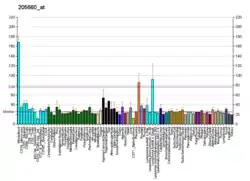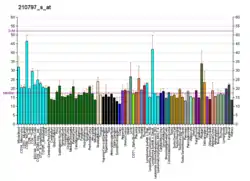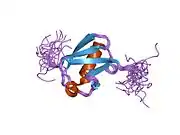OASL
59 kDa 2'-5'-oligoadenylate synthetase-like protein is an enzyme that in humans is encoded by the OASL gene.[5][6]
2'-5'-oligoadenylate synthase is a protein family of structurally similar proteins, including OAS1, OAS2, and OAS3. OASL, like the proteins of 2'-5'-oligoadenylate synthase family, is induced by interferons.
References
- GRCh38: Ensembl release 89: ENSG00000135114 - Ensembl, May 2017
- GRCm38: Ensembl release 89: ENSMUSG00000041827 - Ensembl, May 2017
- "Human PubMed Reference:". National Center for Biotechnology Information, U.S. National Library of Medicine.
- "Mouse PubMed Reference:". National Center for Biotechnology Information, U.S. National Library of Medicine.
- Hovnanian A, Rebouillat D, Levy ER, Mattei MG, Hovanessian AG (May 1999). "The human 2',5'-oligoadenylate synthetase-like gene (OASL) encoding the interferon-induced 56-kDa protein maps to chromosome 12q24.2 in the proximity of the 2',5'-OAS locus". Genomics. 56 (3): 362–3. doi:10.1006/geno.1998.5737. PMID 10087211.
- "Entrez Gene: OASL 2'-5'-oligoadenylate synthetase-like".
Further reading
- Mackay V, Linn S (1976). "Selective inhibition of the dnase activity of the recBC enzyme by the DNA binding protein from Escherichia coli". J. Biol. Chem. 251 (12): 3716–9. PMID 776974.
- Lee JW, Choi HS, Gyuris J, et al. (1995). "Two classes of proteins dependent on either the presence or absence of thyroid hormone for interaction with the thyroid hormone receptor". Mol. Endocrinol. 9 (2): 243–54. doi:10.1210/me.9.2.243. PMID 7776974.
- Hartmann R, Olsen HS, Widder S, et al. (1998). "p59OASL, a 2'-5' oligoadenylate synthetase like protein: a novel human gene related to the 2'-5' oligoadenylate synthetase family". Nucleic Acids Res. 26 (18): 4121–8. doi:10.1093/nar/26.18.4121. PMC 147837. PMID 9722630.
- Rebouillat D, Marié I, Hovanessian AG (1998). "Molecular cloning and characterization of two related and interferon-induced 56-kDa and 30-kDa proteins highly similar to 2'-5' oligoadenylate synthetase". Eur. J. Biochem. 257 (2): 319–30. doi:10.1046/j.1432-1327.1998.2570319.x. PMID 9826176.
- Strausberg RL, Feingold EA, Grouse LH, et al. (2003). "Generation and initial analysis of more than 15,000 full-length human and mouse cDNA sequences". Proc. Natl. Acad. Sci. U.S.A. 99 (26): 16899–903. doi:10.1073/pnas.242603899. PMC 139241. PMID 12477932.
- Ota T, Suzuki Y, Nishikawa T, et al. (2004). "Complete sequencing and characterization of 21,243 full-length human cDNAs". Nat. Genet. 36 (1): 40–5. doi:10.1038/ng1285. PMID 14702039.
- Andersen JB, Strandbygård DJ, Hartmann R, Justesen J (2004). "Interaction between the 2'-5' oligoadenylate synthetase-like protein p59 OASL and the transcriptional repressor methyl CpG-binding protein 1". Eur. J. Biochem. 271 (3): 628–36. doi:10.1046/j.1432-1033.2003.03966.x. PMID 14728690.
- Gerhard DS, Wagner L, Feingold EA, et al. (2004). "The Status, Quality, and Expansion of the NIH Full-Length cDNA Project: The Mammalian Gene Collection (MGC)". Genome Res. 14 (10B): 2121–7. doi:10.1101/gr.2596504. PMC 528928. PMID 15489334.
- Scherer SE, Muzny DM, Buhay CJ, et al. (2006). "The finished DNA sequence of human chromosome 12". Nature. 440 (7082): 346–51. doi:10.1038/nature04569. PMID 16541075.
This article is issued from Wikipedia. The text is licensed under Creative Commons - Attribution - Sharealike. Additional terms may apply for the media files.







